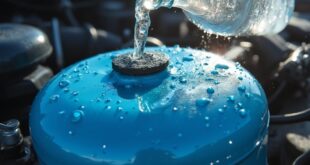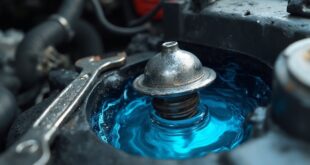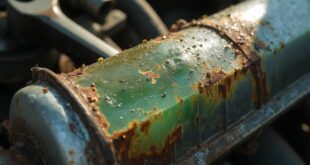If your car heater isn't blowing warm air, start by checking your coolant levels—make sure they're between the MAX and MIN marks. Next, inspect the thermostat for any issues, as a faulty one can prevent your engine from heating properly. Don't forget to assess the heater flaps and blend door actuators, as they control airflow. Finally, examine the heater core for blockages and look for leaks in the coolant system. You'll discover even more tips to solve the problem.
Check Coolant Levels
One of the first things you should do when your car heater isn't blowing warm air is to check the coolant levels.
Open the hood and locate the coolant reservoir, typically marked with MAX and MIN indicators. Make sure the engine's cool to avoid burns while you inspect.
If the coolant is low, it might indicate a leak that needs urgent attention. Additionally, low coolant can trap air bubbles in the system, affecting heating efficiency.
If necessary, refill the coolant and consider bleeding the cooling system to eliminate trapped air. Keeping coolant levels adequate is essential for proper heating performance.
Inspect the Thermostat
While checking the coolant is essential, don't overlook the thermostat, as it plays an important role in regulating your engine's temperature.
If the thermostat is malfunctioning, it mightn't allow the engine to reach the ideal temperature, leading to cold air from your heater.
Keep an eye on your temperature gauge; if it's fluctuating or staying low, that's a sign of a potential issue.
Replacing a faulty thermostat can be straightforward and is often necessary to restore proper heating.
Don't hesitate to consult your vehicle's manual or a professional if you're unsure about the thermostat's condition.
Assess Heater Flaps and Blend Door Actuators
If you're still experiencing cold air after checking the thermostat, it's time to assess the heater flaps and blend door actuators. These components control airflow and can disrupt heating if they're malfunctioning. You may need to inspect the actuators for errors or manually check the flaps.
| Issue | Symptoms | Solution |
|---|---|---|
| Broken Heater Flaps | Inconsistent airflow | Replace flaps |
| Defective Actuator | No heat in cabin | Reprogram or replace |
| Blocked Airflow Path | Cold spots | Clear obstructions |
Check these parts to guarantee warm air circulates effectively!
Examine the Heater Core
After checking the heater flaps and blend door actuators, the next step is to examine the heater core. A clogged heater core can prevent warm air from reaching your cabin.
Look for signs of rust or debris in the coolant, which can indicate blockage. You might also notice a sweet smell inside the car, suggesting a coolant leak.
Flushing the heater core can sometimes solve the issue, but if it's severely clogged, replacement may be necessary.
Keep in mind that accessing the heater core can be complex, so don't hesitate to consult a professional if needed.
Identify and Fix Coolant Leaks
One of the first steps in fixing coolant leaks is to visually inspect the entire cooling system.
Look for any signs of leakage, such as puddles underneath your car or corrosion around hoses and connections.
If you spot a leak, here's what to do next:
- Tighten Loose Hose Clamps: Sometimes, simply tightening the clamps can stop the leak.
- Replace Damaged Hoses: If hoses are cracked or worn, it's best to replace them.
- Check the Radiator: Inspect the radiator for cracks or holes that may need repair.
Addressing these issues can help restore your car's heating efficiency.
Frequently Asked Questions
How Often Should I Check My Car's Coolant Level?
You should check your car's coolant level at least once a month or before long trips. Keeping an eye on it helps prevent overheating and guarantees your engine runs efficiently, prolonging its lifespan.
What Are the Signs of a Failing Heater Core?
If your heater core's failing, you might notice reduced heat, a sweet coolant smell inside your car, or foggy windows. You could also experience coolant leaks under the vehicle, indicating a serious issue.
Can Using the Wrong Coolant Affect Heating?
Using the wrong coolant can definitely affect heating. It may not circulate properly or offer adequate temperature regulation, leading to inefficient heating and potential engine damage. Always use the manufacturer's recommended coolant for peak performance.
Is It Safe to Drive With a Malfunctioning Thermostat?
It isn't safe to drive with a malfunctioning thermostat. Your engine may overheat or fail to reach ideal temperature, risking serious damage. Get it checked and replaced promptly to avoid costly repairs and unsafe driving conditions.
How Can I Prevent Coolant Leaks in the Future?
To prevent coolant leaks, regularly check your coolant levels and inspect hoses for wear. Guarantee your radiator cap fits tightly and address any signs of corrosion or damage promptly to maintain a healthy cooling system.
 Car Service Land Coupons for Oil change, Tires, Wheel alignment, Brakes, Maintenance
Car Service Land Coupons for Oil change, Tires, Wheel alignment, Brakes, Maintenance




